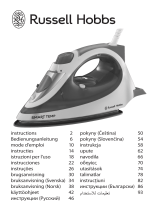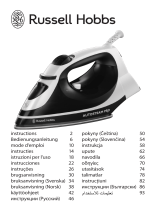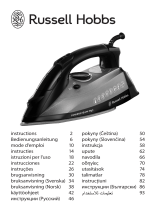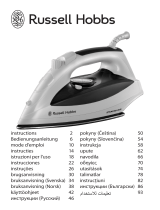Page is loading ...

r
I www.russellhobbs.com
25400-56
GB
DE
FR
NL
IT
ES
PT
DK
SE
NO
FI
RU
CZ
SK
PL
HR
SI
GR
HU
TR
RO
BG
AE

3
Read the instructions, keep them safe, pass them on if you pass the iron on.
IMPORTANT SAFEGUARDS
Follow basic safety precautions, including:
This appliance can be used by children aged from 8 years and above and
persons with reduced physical, sensory or mental capabilities or lack of
experience and knowledge if they have been supervised/instructed and
understand the hazards involved. Children shall not play with the
appliance. Cleaning and user maintenance shall not be done by children
unless they are older than 8 and supervised. Use and store the appliance
out of reach of children under 8 years.
Use the iron, or set it on its heel, on a stable, level, heat-resistant surface,
preferably an ironing board.
Don’t leave the iron unattended while plugged in, or while it’s standing on
the ironing board.
Unplug the iron before lling, before cleaning, and after use.
Don’t operate the appliance if it’s dropped or damaged, or if it
malfunctions or leaks.
If the cable is damaged, return the iron, to avoid hazard.
h The surfaces of the appliance will get hot during use.
H Do not use this appliance near bathtubs, showers, basins or other vessels containing water.
• Don’t iron clothing while it’s being worn – you’ll injure the wearer.
• Don’t use the appliance for any purpose other than those described in these instructions.
• Don’t scratch the soleplate – avoid buttons, zips, etc.
• The appliance has a protective thermal fuse, which will blow if it overheats. If this happens, the
appliance will stop working, and must be returned for repair.
HOUSEHOLD USE ONLY
PARTS
1. Temperature conrtol
2. Soleplate
3. Heel
4. Light
5. Steam control
6. Water inlet
7. Cover
8. Spray nozzle
BEFORE USING FOR THE FIRST TIME
• Remove labels, stickers and packaging from the iron and soleplate.
• Don’t worry if the iron smokes a bit at rst. This is normal and will soon disappear.
• Iron an old piece of cotton fabric, to clean the soleplate.
GB
DE
FR
NL
IT
ES
PT
DK
SE
NO
FI
RU
CZ
SK
PL
HR
SI
GR
HU
TR
RO
BG
AE

4
AUTO SHUTOFF
• If the iron is motionless, it will switch o after about 30 seconds with the soleplate down, or about 8
minutes if it’s upright.
• The temperature light will ash yellow, and keep ashing till you move the iron.
• To switch on again, lift it up, tilt it forward, then sit it upright to return to operating temperature.
• The temperature light will ash the colour appropriate to the current setting till it reaches operating
temperature.
PREPARATION
1. Check for textile care symbols (i j k l).
2. Iron fabrics needing low temperatures j rst, then those that need medium temperatures k, and
nish with those needing high temperatures l.
TEMPERATURE SETTING GUIDE
Label marking Temperature setting
j cool – nylon, acrylics, polyester
•
k warm – wool, polyester mixtures
••
l hot – cotton, linen
•••
Max – denim Max
i do not iron
-
If the instructions on the fabric label dier from this guide, follow the instructions on the label.
FILLING
You may use the iron with tap-water, but if you live in a hard water area, you should use distilled water (not
chemically descaled or softened water).
If you buy distilled water, check that it’s marketed as suitable for use in irons.
1. Unplug the iron.
2. Open the water inlet cover.
3. Pour slowly, to let the air in the reservoir escape, otherwise you’ll cause an air lock and the water will
overow.
4. Don’t ll past max, or water will escape in use.
5. Wipe up any spillage.
SWITCH ON
1. Sit the iron on its heel.
2. Put the plug into the power socket (switch the socket on, if it’s switchable). The iron will beep and
the light in the handle will come on yellow, to show it’s in standby mode.
3. Press and release the temperature button to select the temperature you want.
4. The colour of the temperature light depends on the setting. The colours are:

5
Temperature light colour Temperature setting
Yellow Standby mode
Blue
•
Purple
••
Green
•••
Red Max
5. The temperature light will ash while the iron is heating up, then come on continuously when the set
temperature is reached.
REDUCING TEMPERATURE
This takes a bit longer, as the iron has to lose the heat it has built up, so be patient. It’s best to organise
your ironing so that you don’t need to reduce the temperature.
STEAM IRONING
1. When steam ironing, you must set the temperature to ••• (green) or max (red).
2. Set the steam control to the setting you want, n = no steam, w =high steam.
3. Wait till the temperature light stops ashing, then start ironing.
SPRAY
Water spotting aects some fabrics. Test this out on a hidden part of the fabric.
1. Lift the iron o the fabric.
2. Aim the spray nozzle at the fabric.
3. Press the Sbutton – you may have to press it 2 or 3 times to pump water through the system.
SHOT OF STEAM
This works with dry or steam ironing, as long as there’s water in the reservoir, and the temperature is set to
••• (green) or max (red).
1. Check that the temperature is set to ••• (green) or max (red).
2. Lift the iron o the fabric.
3. Press the P button.
4. Leave 4 seconds between shots, to let the temperature build up.
DRY IRONING
If you’re going to be dry ironing for 20 minutes or more, empty the reservoir rst, to avoid spontaneous
bursts of steam.
1. Set the steam control to n .
2. Select the required temperature.
3. Wait till the temperature light stops ashing, then start ironing.
GB
DE
FR
NL
IT
ES
PT
DK
SE
NO
FI
RU
CZ
SK
PL
HR
SI
GR
HU
TR
RO
BG
AE

6
VERTICAL STEAMING
Remove wrinkles from hanging clothes, hanging curtains, and furnishing fabrics.
• Check that there’s adequate ventilation behind the fabric, otherwise moisture may build up, causing
mildew.
• Check that there’s nothing behind the fabric that may be damaged by the steam.
• Check that pockets, turn-ups, and cus are empty.
• Check that there’s water in the reservoir.
1. Set the temperature control to max (red). Set the steam control to n .
2. Wait till the light stops ashing.
3. Lift the iron o the fabric.
4. Press the P button.
• Leave 4 seconds between shots, to let the temperature build up.
AFTER USE
1. Unplug the iron.
2. Open the water inlet cover.
3. Turn the iron upside down over a sink, and drain the reservoir.
4. Close the water inlet cover.
5. Sit the iron on its heel till it’s cold.
6. Wipe outer surfaces with a damp cloth.
7. Remove spots from the soleplate with a little vinegar.
8. Store the iron on its heel, to avoid corrosion.
SELF CLEAN
To reduce scale build-up, use the self clean function at least monthly in normal water areas, more often in hard
water areas. Products returned under guarantee with faults due to scale will be subject to a repair charge.
You’ll need a basin or a large bowl to catch the water coming out of the soleplate.
1. Fill the reservoir to the max mark.
2. Sit the iron on its heel.
3. Put the plug into the power socket.
4. Set the temperature to max (red), and wait till the temperature light stops ashing.
5. Now hold the iron over the basin or bowl, with the soleplate down.
6. Press the C button and hold it down.
7. Gently move the iron to and fro, over the basin or bowl.
8. Water and steam will wash scale and dust through the soleplate.
9. Continue until the reservoir is empty. Release the C button.
10. Unplug the iron, and sit it on its heel to cool.
ANTISCALE
The anti-scale agent incorporated in the iron helps prevent the build-up of scale.
Don’t use a descaling solution, or you’ll destroy the anti-scale agent.
RECYCLING
W
To avoid environmental and health problems due to hazardous substances, appliances
and rechargeable and non-rechargeable batteries marked with one of these symbols
must not be disposed of with unsorted municipal waste. Always dispose of electrical
and electronic products and, where applicable, rechargeable and non-rechargeable
batteries, at an appropriate ocial recycling/collection point.

103
GB
DE
FR
NL
IT
ES
PT
DK
SE
NO
FI
RU
CZ
SK
PL
HR
SI
GR
HU
TR
RO
BG
AE
/








